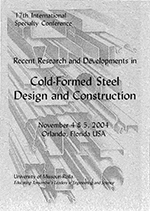Ultimate strength of a continuous decking of cold-drawn low-ductility high strength steel
Abstract
Profiled decking of cold-drawn low-ductility high strength steel is a relatively new introduction to composite floor construction. This type of decking shows high sensitivity to distortional as well as local buckling. Prediction of ultimate strength of such decking in continuous configuration is not adequately covered in any of the analytical methods of modem day codes. Instead, due to inadequate guidance, various design codes currently apply additional restrictions on their design and use. The support moment-rotation and ultimate moment of resistance of such decking are the two most important parameters in designing such decking as continuous structure for the construction stage of a composite floor. The current practices require laboratory testing to determine these parameters, which is costly. Finite element analyses are rarely used to derive these parameters. The present paper deals on prediction of ultimate strength of such a decking in continuous configuration using parameters derived from nonlinear finite element analyses. It is demonstrated that a nonlinear finite element model can give a superior estimates of the parameters needed for ultimate strength design of such a decking.
Ultimate strength of a continuous decking of cold-drawn low-ductility high strength steel
Profiled decking of cold-drawn low-ductility high strength steel is a relatively new introduction to composite floor construction. This type of decking shows high sensitivity to distortional as well as local buckling. Prediction of ultimate strength of such decking in continuous configuration is not adequately covered in any of the analytical methods of modem day codes. Instead, due to inadequate guidance, various design codes currently apply additional restrictions on their design and use. The support moment-rotation and ultimate moment of resistance of such decking are the two most important parameters in designing such decking as continuous structure for the construction stage of a composite floor. The current practices require laboratory testing to determine these parameters, which is costly. Finite element analyses are rarely used to derive these parameters. The present paper deals on prediction of ultimate strength of such a decking in continuous configuration using parameters derived from nonlinear finite element analyses. It is demonstrated that a nonlinear finite element model can give a superior estimates of the parameters needed for ultimate strength design of such a decking.



